
This represents an interesting problem. There are no clear indications in the Super Sagas or in Dent's notes as to the ages of Pat Savage or the Five Aides. People have speculated about this but in many cases I think they have severely underestimated the men's ages. This was considered necessary because otherwise the Crew would have been a bunch of old men in the 1930s and 1940s.
But I think that we have to assign them ages that are commensurate with their professional accomplishments,and with their military ranks during and at the end of the Great War in the Super Sagas and in Phillip José Farmer's Escape from Loki. It is our assumption that since all of Doc's men are the tops in their fields, they have obtained the highest academic credentials which would mean doctorates. That would require a total of at least 8 years of graduate and post-graduate training if not more. It would also take several years to build up a reputation and establish oneself in one's chosen discipline. If we assume that they entered college at the age of 16-18 years old, they would have had to have been at least 29-35 years of age in 1918 during the Great War. (Long Tom is the sole exception to this rule. He was a few years younger for reasons I will explain shortly.) That means that in 1931 when the storyline of the Super Sagas actually began, each of the four other aides would need to be a minimum of 42 years old and probably more like 45-50 years of age if not older. That is awfully long in the tooth to be going around chasing bad guys and getting coshed in the head regularly as Monk did. This is especially true in 1933 when medicine was not as advanced as it is today and lifestyle interventions for chronic disease were limited to rest or exercise or a very few medicines. Age would have caught up with these guys a lot faster than it does today.
We avoid the aging problems by acknowledging (as I did in my article on Monja F'Teema ) that in 1925, Clark Sr. had developed an anti-aging elixir which he shared with his son and eventually with his son's companions. This makes it possible for us to accept ages for the Fab Five that would otherwise be unthinkable.
Let's first deal with Patricia Savage, Doc's younger cousin. According to the consensus article on the Doc Savage Chronology at the Wold Newton Universe Website, she was born in 1914. We know she was the only daughter of Doc's uncle Alex Savage who lived on a ranch in Canada that her grandfather had founded. No mention is ever made of her mother. We first meet Pat in the Super Saga Brand of the Werewolf (January, 1934). At that time she would therefore have been 20 years old. This is a credible age for her. She is described as a young woman, not as a minor. In the subsequent Super Saga Fear Cay (September, 1934) Pat had moved to New York and opened a Beauty Salon and Spa that catered to a rich clientele. She worked at this business for the duration of the Super Sagas and was quite successful with it. It is never mentioned whether or not she became a US Citizen.
Some have speculated that she was 18 in 1934, but I do not think that is credible. She would have been too young to own a business and would more likely have gone to college instead. As it stands, we must assume that she had already attended College and received her degree, probably in business.
John 'Renny' Renwick was a construction engineer who had an excellent reputation prior to the Great War. In Escape from Loki, Monk recognized him at the German prison camp, Loki, in April 1918 as an old drinking buddy with whom he had built a chemical plant in Brazil a few years before the war. At Loki, Renny was a Captain in the Army Corp of Engineers. We know by the end of the year (i.e., after November 11, 1918 when the Armistice was signed) he would be discharged with the rank of full Colonel (Likely a brevet rank given so that he could fill a high level staff position). Renny was also the most accomplished marksman, driver, outdoors man, hunter, and pilot of Doc's aides. These were all skills he picked up working as an engineer in the field. (He also became the best fighter but only after Doc started instructing him in Karate techniques in later years which took advantage of his huge hands.) So I would estimate that Renny would have had to be 36 years of age in 1918 meaning that he had been born in 1882.
Thomas "Long Tom" Roberts was a First Lieutenant in the Signal Corp at Loki. Since he made Major by the end of the year (which was probably also a brevet rank) he must have been in his late 20s. In my short story Long Tom Robber (Soon to be published in Zine of Bronze #4) I tell what really happened with the 'Long Tom' cannon in that French town. I thought it was interesting that Long Tom earned his nickname not for an electronic device but for the makeshift use of an old mechanical device: a cannon. As I did my research I realized that Long Tom had not only studied with the great electronic geniuses Steinmetz and Tesla but also with Thomas Edison who was an inventor who delved into several fields including mechanical engineering. I also discovered interesting parallels between Long Tom Roberts and another famous inventive 'Tom': Tom Swift.
Tom Swift had dabbled in electronics, automotive, aeronautics, and even war devices including a "War Tank" and a "Giant Cannon." If they were the same person, it would explain why Long Tom would have felt confident enough to refurbish and use that old French cannon. He had had some prior experience with artillery. Tom Swift had some other interesting parallels with our Long Tom. They were both blond and blue eyed. They both worked on projects for the US Government before, during, and after World War I and World War II. And in 1929, Tom Swift married his sweetheart Mary Nestor. We have always read in the Super Sagas that Long Tom was a misogynist: a woman hater. While the other fellows were out chasing skirts (even Doc dated regularly in the 1940s) Long Tom was never moved by feminine pulchritude. The sole exception to this that I know of was in The Feathered Octopus (September, 1937) where Long Tom was smitten by the tall blond Valkyrie-like Lam Benbow. Even a married man is allowed a (platonic) crush now and again. But in-between, he will seem like a woman-hater when in reality he is just a woman-avoider trying to remain faithful to his spouse. Also Long Tom did not smoke or drink and neither did Tom Swift. Swift's father was plagued with lung and heart problems likely due to the common American habit of cigarette smoking. He may also have had an alcohol problem, though the Tom Swift stories do not say this. Such a problem would explain why his son would not drink alcohol. The impact of seeing what cigarettes (and alcohol?) did to his father might have made Long Tom into a non-smoking teetotaler. And the name "Swift" sounds like one of those semi-pejorative nicknames that smart kids got from the more average boys in their neighborhood.
According to the Tom Swift experts, he had been born in 1893 and would have been 25 years old in 1918. His first adventure, Tom Swift and his Motorcycle, was published in 1910 when he was 17 years old. That would also have been the right age for Long Tom by my reckoning since he was a Lieutenant at Loki in 1918. Supposedly, Swift had been home-schooled by his father to a college level with a heavy concentration in physics and mechanics. He had attended the local Public School for First Grade but the curriculum was so far behind his abilities that his father decided to teach the child himself. Tom had also been an active inventor since before he was 17, so he had started his life's work at an earlier age than the other Savage Aides. Through the social contacts of his father (who was also an inventor) he met and studied with many of the greatest American inventive minds of the time including Edison, Steinmetz, Tesla, Marconi, and Westinghouse.
Tom Swift took the entrance exams and made it into the MIT graduate division receiving credit for an undergraduate degree in physics at the age of 18. He earned his doctorate in Mechanical Engineering at the tender age of 22. He became more and more obsessed with electronics and all of its possible practical application over time. Before the Great War he had begun working on graduate studies in electronics and Electrical Engineering which he completed when he returned Stateside qualifying for a second doctorate. All of this fits our portrait of Long Tom. it also helps explain why he was not in many of the Super Sagas. He had a parallel set of adventures with his friends and family many of which have been chronicled under his boyhood nickname.
William Harper "Johnny" Littlejohn was a civilian during the Great War who was working secretly for US Army Intelligence while he was on an archaeological dig outside of Munich, Germany. He was caught in Germany after the US declared war and was interned in a civilian detention camp. He proved to be a difficult to keep imprisoned and so they sent him to the Loki camp with the incorrigible military prisoners. This was technically illegal. We are told in Escape from Loki that he had already earned a doctorate in Geology and was almost finished with a second doctorate in archaeology. Very likely he was already a full professor and had travelled to Germany during his sabbatical year to perform an archaeological dig as a requirement for his second doctorate. This would mean that he was at least seven years out from his first degree, if not longer.
It should also be noted that many intelligence agents were (and are) recruited in college as undergraduates usually during war time. For Johnny, this could have been around the turn of the century. He may have been recruited during the Spanish American War in 1898 and been an operative in Cuba. Later in 1903, the US instigated the revolution in Panama against the Colombian government which resulted in the US gaining control of the Panama Canal. It would not have been unusual for an American geologist to have been in Panama at that time and to have acted as an agent provocateur. In fact, Johnny's career as a geologist and an archaeologist would have been a good cover for traveling around the world and acting as a covert agent for Uncle Sam. We know that this was true in Germany in 1918.
So I propose that Johnny was born in 1880 and thus was 38 years old in 1918 at the time he was in Loki. By then, he was a seasoned intelligence agent with twenty years of experience in covert operations. It is to his credit that he simultaneously had a brilliant career in academia as well as a lucrative one involving the practical aspects of geology and archaeology. In fact, he had more breadth of knowledge in different areas than any other of Doc's aides. It included not only his primary areas of study but anthropology, folklore, linguistics, paleontology, religious studies, the classics, history, literature, economics, politics, and diplomacy.
Andrew Blodgett "Monk" Mayfair was an Infantry Lieutenant Colonel in 1918 at Loki. He also was a Chemist and Chemical engineer with an international reputation. He and Renny had first met on a chemical plant building project in Brazil a few years before the Great War. Some Savageologists have proposed 1894 as the birth year for Monk, but this is not credible. That would have made him only 24 in 1918 which is barely old enough to have gotten his doctorate and is not compatible with his being a renowned expert in his field before the war. It was also too young for him to have been a Lieutenant Colonel in 1918.
It has come to my attention that Monk was a member of the famous (infamous?) New Orleans Mayfair family whose history has been chronicled by author Anne Rice in her novels The Witching Hour, Lasher, and Taltos. These Mayfairs had a high degree of psychic ability which might explain Monk's telepathic capabilities in the 1930s. He and Ham were sometimes able to exchange thoughts even over long distances. [See for example The Mountain Monster (1937).] It might also explain his facility with chemistry which is just another way of concocting useful potions. Such things were in his blood.
I noted that in The Witching Hour there was a curious story. In 1888, Julien Mayfair took his niece (who was likely also his daughter) Mary Beth Monahan on a trip to Europe. Mary Beth was described as a large stocky woman with coarse features who could pass for a man in middle age. While in Scotland that year, she allegedly married a 'Lord Mayfair' who was a distant relative and was impregnated by him. There was never any documentation of such a marriage and the stories about their time in Scotland were full of contradictions. The alleged 'Lord Mayfair' supposedly died under mysterious circumstances shortly after he impregnated Mary Beth. Mary Beth had a child, Belle, in Scotland in 1889. In Lasher, the ghost of Julien says to Michael Curry that Mary Beth went out nightly to local drinking places and one morning returned saying that she had chosen a man and gotten herself pregnant by him the previous night. (As a witch, I supposed she had knowledge of such things.) But the ghost of Julien admitted that he often told plausible lies to cover up family problems. The Talamasca scholars who chronicled this incident thought that Belle was sired incestuously by Julien, but no one in the family believed that. I have a different proposal.
In 1886, Robert Louis Stevenson published his classic horror novella The Strange Case of Dr. Jekyll and Mr. Hyde in which the timid Dr. Henry Jekyll discovered a chemical formula that transformed him periodically into the brutish and "ape-like" Mr. Edward Hyde. The story ends with Dr. Jekyll on the verge of a permanent change into Mr. Hyde. Supposedly, Hyde committed suicide at the end of the story, but that could have been a cover-up for his disappearance. Rumors that he still lived circulated for years afterwards.
There has been much speculation as to the type of elixir that Dr. Jekyll had concocted. Some thought that it was a psychotropic drug that induced in him a state of multiple personality disorder. I submit that in fact, the elixir had a direct effect on his genome and that it activated latent atavistic genes that were present in his "junk DNA" leading to a reversion to a more primitive body type. We know from the Anne Rice novels Lasher and Taltos that some members of the Mayfair family carried a double set of chromosomes which included material that was only marginally human. We may surmise that Dr. Jekyll was also a carrier of these odd chromosomes which made him susceptible to this transformation. The process was gradual -- albeit with fits and starts -- but progressive and irreversible. It even affected his reproductive cells so that the newly activated traits could be passed on to his children. (Something similar happened to Michael Curry from Anne Rice's Mayfair Witches series under the influence of the demon Lasher that caused him to father two different Taltos children by Rowan Mayfair and Mona Mayfair.) Mr. Hyde manifested hybrid vigor showing not only tremendous physical strength but increased intelligence as well.
The events in the novella apparently transpired 2 or 3 years before the story was published. Around that time a curious incident occurred. There was a Dr. William Rutherford who had been a teacher of Arthur Conan Doyle. He and his entire family were stout brutish men with short tempers. He had a young cousin, George Rutherford who lived in the village of Largs in Scotland. George was a bit of a rakehell and in his youth sowed his wild oats extensively. As a consequence of his dissolute lifestyle, he found himself alienated from the mainstream of the Rutherford family in Edinburgh and ended up on a small estate in the country. He and his wife had only one son -- also named George -- who had been born in 1863 and educated in boarding schools. Young George was nondescript and prone to depression. He completed his basic education before being forced to return to Largs to care for his ailing parents. They were the poor relations that the rest of the family did not acknowledge. In 1884, the elder George and his wife succumbed to consumption and young George -who was now alone in the world and penniless - disappeared. The Largs estate was liquidated to pay off the family's creditors.
Then in 1886 a man claiming to be young George Rutherford began his studies at Edinburgh University. He claimed to have made money in business ventures overseas in order to pay for his education. He was a fiery red headed bull of a man with a short temper who was prone to violence. He was rude, crude, and lacking in both conscience and social inhibition. He was also a brilliant scientist. He completed degrees in Medicine, Zoology, and Anthropology. He was an iconoclast who challenged the accepted wisdom in all areas including morals. He was given the nickname "Challenger" by his classmates. Upon achieving his first doctorate he legally changed his name to 'George EDWARD Challenger'. He stated that the Rutherford family had abandoned him and his father so in his success he was abandoning them. He preferred to be called 'Eddie' by his friends. He eventually married a French woman, Enid Delagardie, to whom he became devoted and who was the one civilizing force in his life. On his trip to The Lost World, Challenger was noted to resemble the primitive ape-men on the plateau and to be rather ape-like in his body habitus.
I submit that George Edward Challenger was actually Mr. Edward Hyde who had either killed or discovered the death of young George Rutherford and assumed his identity. Based on what we know about the older George Rutherford's promiscuity, it is entirely possible that Henry Jekyll may have been his illegitimate son which would explain Hyde's physical similarity to young George.
There were several Rutherfords in Edinburgh none of whom really knew their obscure cousin and so the impostor was able to bluster his way into the family. Hyde had a rough physical resemblance to George Rutherford which he decided to exploit to create a new life and career for himself. John Rutherford of Edinburgh practically adopted him as his own son.
Mary Beth's brother, Vincent Blodgett Mayfair, had married Melissa Rutherford the daughter of John Rutherford. They had had met while they were each on vacation in the south of France. They had recognized an odd 'connection' when they first set eyes on each other. It may very well be that the Rutherford clan carried some Taltos blood in them and that they represented another line of genetic witches.
The New Orleans Mayfairs (of French extraction) had intermarried with some Canadian Mayfairs (of British extraction). The Canadian Mayfairs were quite familiar with the Rutherfords of Scotland and it appears that they introduced the New Orleans Mayfairs to the Rutherfords.
Julien and Mary Beth visited the Rutherfords while they were in Scotland and it was there that they met young 'George Rutherford.' He either seduced Mary Beth or raped her And as a result she became pregnant. It is not clear exactly what happened. It is alleged in Rice's novel Lasher that "Lord Mayfair" died on the night he seduced Mary Beth, but no proof is ever given for this. In any case my sources indicate that Mary Beth was terrified of the man who impregnated her and wanted nothing to do with him thereafter. It seems this lover was the only person Mary Beth ever came to fear. She apparently tried to control him with her telepathic powers but found she could not. Even the demon Lasher was cowed by this man's sheer brute power and was not able to harm him.
There was a quiet furor when John Rutherford found out that his brutish cousin had ravaged and impregnated Mary Beth. This incident along with George Ruherford's arrogance and generally uncouth behavior alienated him from the rest of the Rutherford family and led to him legally change his name to 'Challenger.'
Mary Beth bore twins in 1889: a boy and a girl in London. The boy she named Andrew. He was a brutish looking child that strongly resembled his biological father. Mary Beth found that likeness upsetting and could not stand to be around the child. The other twin, a daughter she named Belle, was a beautiful child and it was always preferred in the Mayfair line that the priamry heir be a woman. Even though she knew that Belle did not share her powers and thus was not a fit heir to the Mayfair legacy, Mary Beth loved the baby and kept her. But she wanted nothing to do with Andrew.
Julien arranged for Andrew to be brought to the United States and had him adopted by Mary Beth's brother Vincent and his wife Melissa. Thus the child was raised by his aunt and uncle. They had been childless despite years of trying and were more than happy to have a son. Such arrangements done discretely were not uncommon in Victorian times. This would explain why the family refused to believe that Julien was Belle's father. Her real father's identity was a family secret.
Mary Beth was an odd person. She was a big boned woman who often dressed as a man and cavorted around the night spots in New Orleans. She was a tough, ruthless business woman and she became the Matriarch of the Mayfair family. Under her leadership, the Mayfairs made numerous successful investments around the United States and the world.
At his sister Mary Beth's request, Vincent moved to Oklahoma City where he managed the Mayfair interests and became a successful commodities broker. He also maintained a home in Tulsa and had a an ersatz birth certificiate filed there for Andrew. He and his family often returned to New Orleans for visits and also went to Europe almost yearly. They also took trips to other major American cities to which the Mayfair family had spread. They had several cousins in New York and Boston and Andrew spent some summers with them as a teenager. He even did some odd jobs for spending money, once serving as a messenger boy for Grand Central Station.
Because Vincent's family was raised so far from the Mayfair family influence, the custom of speaking French in the home was not preserved. After Andrew came to live with Vincent and Melissa, their fertility problems ended and they had several more children. Melissa died in 1912 while Andrew was finishing his graduate training. Vincent married a younger Irish-German woman in 1915 whose father owned a brewery in New Orleans. The couple also had several children. They eventually moved back to New Orleans to be closer to family. Most of their descendants live there to this day.
Andrew was a precocious child with tremendous physical energy. He was prone to violent fits of temper and was far stronger than any other child in his school. When he was younger, the bigger children taunted him because of his looks. But as he grew bigger and stronger, no one bullied him anymore. Even the older children steered clear of him. He looked mean and had a temper to match. Though he never grew much over 5 feet tall, he went through puberty early and at 12 he could pass for a man of 18.
Andrew had a genius IQ despite his simian appearance. He had a fascination with chemistry and unlike most of his educated cousins was not interested in pursuing a career in either the law or business. There were no good schools in Tulsa that could meet his special needs so he was educated in boarding schools prior to going to college. Andy actually spent some time as a student in the famous Rugby School in England, but he did not get on well with his British classmates. After just a fews years there, he was taken back to the United States and completed his high school work in a Jesuit School in New Orleans.
Several of the Mayfair cousins attended Harvard, but Andrew found Boston too tame and staid. He also found New Orleans to be too old fashioned and languid for his likings. He had fallen in love with New York City, its shows, its modern pace, and its active night life. His "aunt" Mary Beth had tried to pursuade him to attend Loyola, the Jesuit University in New Orleans where her sister Carlotta was studying, but he wanted to live in New York.
He was accepted at age 15 to Fordham, the Jesuit University in New York which pleased his family. He received an undergraduate degree in Chemistry Summa Cum Laude. He did graduate work both at Fordham and Columbia earning a doctorate in Chemistry and a Masters in Chemical Engineering. He spent some time in Leipzig during his post-graduate training. Monk was offered a faculty position at Columbia which he accepted, but he also did consulting work which was his real forte. In 1914, he received his first big break. His Master's thesis on chemical synthesis had so impressed his advisers that they brought it to the attention of a major chemical company. The company hired Andrew on the spot to build a plant in Brazil that would use his new process. He was given full credit for his ideas and received several patents. These would be the first in a long string of such patents which would earn him income for the rest of his life. While he remained affiliated with the faculty at Columbia, his full time job was to be a free-lance consultant on chemical engineering for a variety of major corporations.
When war broke out in 1914. Monk was in Italy. He had a hankering for a good scrap and so he joined the Italian Army. After a severe injury, he was discharged and went to England to recuperate. As he recovered, he assisted in training British troops about chemical warfare and was granted a commission in the British Army.
When the US went to war, Andrew returned to America and volunteered for the US Army. He received a commission in the infantry and based on his experience was granted the rankof Lieutenant Colonel. The Mayfairs were of French ancestry and his whole family had a strong affinity for the suffering of the French people during the war. Because of his background in chemistry he became an exchange officer first with the British chemical forces and then with one of the French Z-Units that utilized offensive poison gas weapons. His recommendations early in America's involvement in the Great War lead to the adoption of French tactics in offensive chemical warfare by the American Expeditionary Force. It was while serving with the French that he met Ham Brooks who was then in the Foreign Legion. Monk was granted a brevet rank of Lieutenant Colonel and acted as a special staff officer for chemcial affairs to General Pershing. There would not be any formal Gas Warfare branch in the US Army until late 1918 so Monk remained officially in the infantry.
Monk was a raucous man who was always out for a good time. He liked cold beer, hot jazz, fast women, sloe Gin, and practical jokes. Needless to say he often got into trouble in Paris. Despite all of his achievements in preparing the AEF for chemical warfare, he was never promoted beyond Lieutenant Colonel and was lucky that he did not get demoted. He spent more than a few nights in the stockade. It was the intercession of Brigadier General Ham Brooks that protected Monk at the end of the war. Ham was sent home in early December 1918 becasue his wife had take ill with the deadly 1918 flu that year. He requested to have Monk sent home at the same time. The Adjutant General was more than happy to oblige.
Theodore Marley "Ham" Brooks has been given a birth year of 1888 by some Savageologists, but I again do not find that credible. This would have made him only 30 years old in 1918 which is far too young for a man who ended the war with the rank of Brigadier General. This is especially true since he was a Lieutenant Colonel in the French Foreign Legion while at Loki and did not return to allied lines until early August 1918. There just was not enough time for a such a young man to have earned that high of a rank.
Instead I propose that he had been born in 1876 and was 42 years old in 1918. We know that Ham had attended Harvard Univeristy and Harvard Law School and graduated with distinction in 1897 having earned a JD. He immediately started post-graduate studies towards an academic LLD doctorate in law. Then the Maine blew up in Havana harbor and Ham volunteered for the 1st United States Volunteer Cavalry Regiment with Theodore Roosevelt and the Rough Riders. He served with them in Cuba during the Spanish American War as a JAG officer, and fought with the unit in each of its battles. He and Roosevelt became friends and the 'Two Teddys' became part of the upwardly mobile social set in New York. Ham Brooks finished his LLD and became a successful business attorney in Manhattan. Eventually he became the founder and senior partner of his own law firm. Ham was married in 1900 to his first wife, Nola, and they had four sons and one daughter. All of these sons became Harvard-educated attorneys and two eventually joined his firm.
In 1914, Ted Brooks was appalled at the brutality and illegality of the German attack through neutral Belgium. He felt strongly that the U.S. needed to weigh in on the side of the British and French but there were strong isolationist and pacifist feeelings in America especially with Woodrow Wilson in the White House. Disgusted, Ted Brooks followed the example of many Harvard men and went to France in early 1915 at the age of 38 to join the foreign legion. He was an enthusiastic soldier and a brilliant tactician. He had been given a commission as a Captain on completing basic training and rapidly was promoted to Major and then Lieutenant Colonel. Such promotions in the Legion for an American were virtually unheard of. He received the Croix de Guerre more than once and several other decorations. He was in fact the most decorated American in the Foriegn Legion by the end of the war.
His most notable achievement was when, as a battalion commander, he deduced a German move to envelop the French division to which his Foreign Legion unit was attached. On his own initiative he used his unit to effectively counter the German manuever. At first his Division commander was unaware of what was happening and was furious with Brooks for departing from the battle plan. When the entire story came out it was clear that Brooks' action had saved the division and he received a Division Croix De Guerre as a result.
When Doc and his men returned to the Allied lines in early August 1918 after escaping from Loki, Ham was transferred to the US Army. Because of special circumstances he was given the brevet rank of Brigadier General. He retired with this rank at the end of the war. At that time he was 42 years old which is still young for a General Officer. The exact cicumstances leading to this promotion will be chronicled in a future story about Ham and Monk that I am in the process of writing for The Zine of Bronze #5.
So in summation, I propose the following birth years for Doc Savage's associates:
Patricia Savage - 1914
Renny Renwick -1882
Long Tom Roberts - 1893
Johnny Littlejohn - 1880
Monk Mayfair - 1889
Ham Brooks - 1876

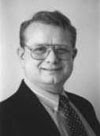

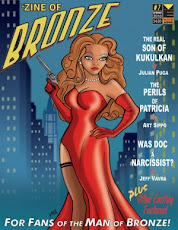
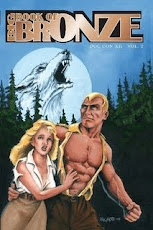



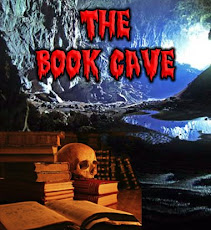





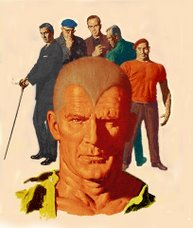

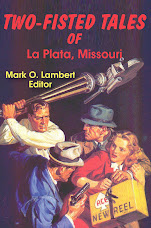









2 comments:
Art,
Like all of your articles this was both informative and entertaining. Although you made a persuasive argument, I am not sold on the family tree you presented for Monk. The Long Tom theory however is very intriguing.
Dennis E. Power
Dennis,
Thank you so much for your kind words. I was reading Anne Rice's "The Witching Hour" about the Mayfair witches of New Orleans when I saw that Mary Beth Mayfair had been impregnated in Scotland in 1888 which was right around the time that Monk would have been born and also when a young George Edward Challenger would have been in University. It then struck me how similar GEC was in character and body habitus to Edward Hyde. Robert Louis Stevenson's story was published in 1886. All the pieces fit. As you noticed, I was able to integrate my revised parentage for Monk into the story of your own article on 'The Rutherfords' without doing (much) violence to your underlying thesis.
As always, we scholars can only propose our findings. Those who follow us will need to confirm or deny them.
And As I have told Win Eckert, I believe in a "Many Worlds Theory" of Wold Newton, so my speculations may exist in a particular one which is different from other ones.
As to the ID of Long Tom and Tom Swift, believe it or not that occurred to me back in 1965 when I was reading the beginning chapters of my first Doc Savage Super Saga "The Land of Terror." I was all of 12 years old and a big fan of comic books and young adult adventure literature. As time went on, I saw increasing parallels between the two characters and I am convinced that my identification is more than plausible. It explains a lot about Long Tom which otherwise remains obscure.
In any case, these speculations are intended to be fun, and I hope people will enjoy them.
Thanks for your comment!
Art
Post a Comment